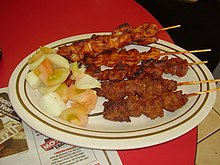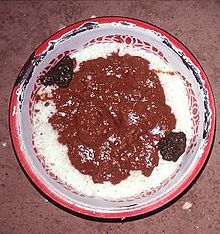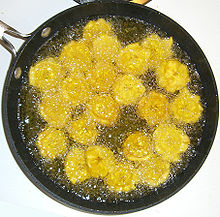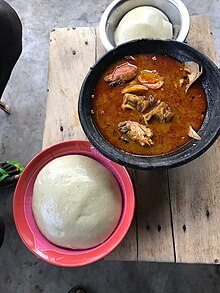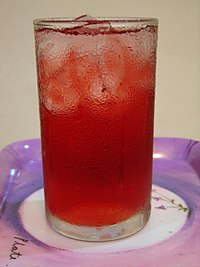
Tripe is a type of edible lining from the stomachs of various farm animals. Most tripe is from cattle, pigs and sheep.

Malay cuisine is the traditional food of the ethnic Malays of Southeast Asia, residing in modern-day Malaysia, Indonesia, Singapore, Brunei, Southern Thailand and the Philippines as well as Cocos Islands, Christmas Island, Sri Lanka and South Africa.

Fried rice is a dish of cooked rice that has been stir-fried in a wok or a frying pan and is usually mixed with other ingredients such as eggs, vegetables, seafood, or meat. It is often eaten by itself or as an accompaniment to another dish. Fried rice is a popular component of East Asian, Southeast Asian and certain South Asian cuisines, as well as a staple national dish of Indonesia. As a homemade dish, fried rice is typically made with ingredients left over from other dishes, leading to countless variations. Fried rice first developed during the Sui Dynasty in China.

The cuisine of the Democratic Republic of the Congo and the Republic of the Congo varies widely, representing the food of indigenous people. Cassava, fufu, rice, plantain and potatoes are generally the staple foods eaten with other side dishes.
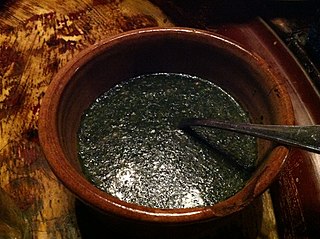
Mulukhiyah, also known as mulukhiyya, molokhiyya, melokhiyya, or ewedu, is a type of jute plant and a dish made from the leaves of Corchorus olitorius, commonly known in English as jute, jute leaves, jute mallow, nalta jute, or tossa jute. It is used as a vegetable and is mainly eaten in Egypt, the Levant, Sudan, Cyprus, Libya, Tunisia and Algeria. It is called saluyot in the Philippines. Mulukhiyah is rather bitter, and when boiled, the resulting liquid is a thick, highly mucilaginous broth; it is often described as "slimy", rather like cooked okra. Mulukhiyah is generally eaten cooked, not raw, and it is either eaten chopped and sautéed in oil, garlic and cilantro like in Syria or turned into a kind of soup or stew like in Egypt, typically bearing the same name as the vegetable in the local language. Traditionally mulukhiyah is cooked with chicken or at least chicken stock for flavor and is served with white rice, accompanied with lemon or lime.

Ghanaian cuisine refers to the meals of the Ghanaian people. The main dishes of Ghana are centered around starchy staple foods, accompanied by either sauce or soup as well as a source of protein. The primary ingredients for the vast majority of soups and stews are tomatoes, hot peppers, and onions. As a result of these main ingredients, most Ghanaian soups and stews appear red or orange.

Peanut stew or groundnut stew, also known as maafe, sauce d'arachide (French) or tigadèguèna is a stew that is a staple food in Western Africa. While maafe is a dish from Senegal, tigadèguèna originates from the Mandinka and Bambara people of Mali.
Sierra Leonean cuisine consists of the cooking traditions and practices from Sierra Leone. It follows the traditions of other West African cuisines. The country has 16 tribal ethnic groups.

Palaver sauce or palava sauce or plasas is a type of stew widely eaten in West Africa, including Ghana, Liberia, Sierra Leone and Nigeria. The word palaver comes from the Portuguese language and means a talk, lengthy debate or quarrel. It is unclear how this led to the name of the stew. One theory is that the spices used in the stew mingle together like raised voices in an argument. It has been thought of as having the power to calm tensions, or to cause them. Other names for the dish include kontonmire, kentumere, nkontommire and pla'sas.

West African cuisine encompasses a diverse range of foods that are split between its 16 countries. In West Africa, many families grow and raise their own food, and within each there is a division of labor. Indigenous foods consist of a number of plant species and animals, and are important to those whose lifestyle depends on farming and hunting.

The cuisine of Equatorial Guinea is a blend of the cuisines of the native peoples of this African country, including the Annobonese, the Bubi, the Fang, and the Kombe. It is also influenced by the cuisines of Spain ; other African nations such as Nigeria and Cameroon; Islamic states such as Morocco; and Creole cuisine overall. Its cuisine incorporates various meats, including game and bushmeat as well as imports, and is known for its strong flavors and high spice levels. Fish and chicken are common dishes.
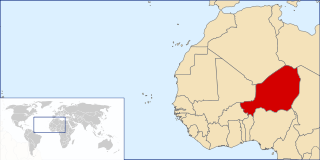
The cuisine of Niger draws on traditional African cuisines. Various spices are used and meals include grilled meat, seasonal vegetables, salads, and various sauces. Meals in Niger usually start with colorful salads made from seasonal vegetables. Moringa leaves are a favorite for a salad.

Malaysian Indian cuisine, or the cooking of the ethnic Indian communities in Malaysia, consists of adaptations of authentic dishes from India, as well as original creations inspired by the diverse food culture of Malaysia. Because the vast majority of Malaysia's Indian community are of South Indian descent, and are mostly ethnic Tamils who are descendants of immigrants from a historical region which consists of the modern Indian state of Tamil Nadu and Sri Lanka's Northern Province, much of Malaysian Indian cuisine is predominantly South Indian inspired in character and taste. A typical Malaysian Indian dish is likely to be redolent with curry leaves, whole and powdered spice, and contains fresh coconut in various forms. Ghee is still widely used for cooking, although vegetable oils and refined palm oils are now commonplace in home kitchens. Before a meal it is customary to wash hands as cutlery is often not used while eating, with the exception of a serving spoon for each respective dish.

Gambian cuisine is part of West African cuisine and includes the culinary practices and traditions of the nation of The Gambia. Common ingredients include fish, rice, peanuts, tomato, black-eyed peas, lemon, cassava, cabbage, Potato, Pumkin,,Garden egg, lettues,rice, coose, corn, ,findi salt, pepper, onion, chili, and various herbs. Oysters are also a popular food from the River Gambia, and are harvested by women.
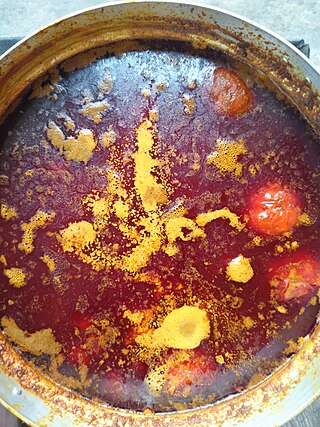
Palm nut soup or banga is a soup made from palm fruit common in the Cameroonian, Ghanaian, Nigerian, Democratic Republic of Congo and Ivorian communities. The soup is made from a palm cream or palm nut base with stewed marinated meats, smoked dried fish, and aromatics. It is often eaten with starch, fufu, omotuo, banku, fonio, or rice. The use of the palm fruit in cooking is significant in Ivorian, Cameronian, Nigerian, Ghanaian, Liberian and other West and Central African cuisine.

Ofada rice is a Yoruba dish. It is the name of an indigenous rice from a small community called Ofada, located in the Obafemi Owode Local Government Area of Ogun State. It is not exclusively grown in the community, but it is an indigenous rice grown in southwest Nigeria but named after the Ofada community. It is used in making a variety of dishes. Ofada rice are mostly blends, and some of the rice varieties in the blends are not indigenous to Africa; however, they usually also contain African rice. It is grown almost exclusively in Ogun State, a state in southwestern Nigeria. Ofada rice is grown on free-draining soil where the water table is permanently below the root of the plant.
Hausa cuisines are traditional and modern food prepared by Hausa people. It is based on the availability of raw food materials they can farm or provide from other places. Most times Hausa people depend purely on the farm products they have cultivated for food preparations. Hausa people have a meal that is common to most Zongo communities called Tuo Zaafi.
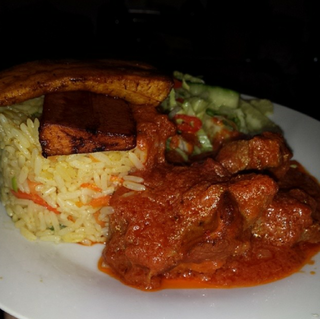
Obe ata (Yoruba) is a stew or sauce used in Yoruba cuisine and meals found in Nigeria, Benin and Togo. In concept, it is similar to that of French mother sauces: a sauce from which other sauces are made, or to the Mexican Mole. It can be used as the base with which Jollof rice is made, either at the initial or near prepared state. Rice, yam and bread are also eaten with it. In Nigerian cooking the sauce is "ubiquitous".

Yoruba cuisine is the numerous and diverse foods of the Yoruba people of Yorubaland. Some notable Yoruba food include : Ofada, Asaro, Moi Moi, Egusi soup, Abula, Akara, Ila Alaspo, Eforiro with Okele, etc.
Obe are Yoruba soups made from different types of vegetables and seeds. It usually contains meat, fish and spices. This is a category of Yoruba cuisine. Obe is usually eaten with Okele, but can be eaten sometimes with rice. Some Obe have the consistency of Sauces so in non Nigerian English they may be called sauces. Obe are varied in ingredients and preparation like Indian Chutney or Mexican Mole. However, Obe is more similar in concept to other West African cultures soup concept. Some types of Obe include:

